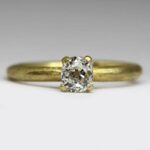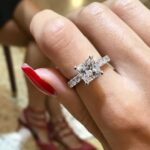The intricate world of diamonds often sparkles with an array of cuts, colors, and shapes that continue to captivate our fascination. Among the various forms of diamonds available in the market, loose diamonds hold a unique position. These unmounted gems offer a whole new realm of possibilities for customization and value. This article aims to shed light on the value of loose diamonds and the factors that contribute to their worth.

Understanding Loose Diamonds
Loose diamonds are essentially diamonds that have been cut and polished, ready to be mounted on a piece of jewelry but have yet to find their setting. They offer the ultimate freedom for customization, allowing individuals to select a diamond that meets their precise specifications and pair it with a setting of their choice.
People buy loose diamonds for various reasons. Some are looking to create a custom piece of jewelry, while others consider them a long-term investment. Regardless of the motivation, understanding the value of these diamonds is critical to making an informed purchase.
Factors Influencing the Value of Loose Diamonds
- Cut: The cut of a diamond significantly influences its value. It refers to the diamond’s proportions, symmetry, and polish, which affect its ability to reflect light and ultimately its brilliance. Well-cut diamonds are more desirable and valuable.
- Color: Diamonds are graded on a color scale established by the Gemological Institute of America (GIA), which ranges from D (colorless) to Z (light yellow or brown). Diamonds closer to the colorless end of the spectrum are rarer and more valuable.
- Clarity: This refers to the presence of inclusions (internal characteristics) and blemishes (external characteristics) in a diamond. Diamonds with fewer and smaller inclusions and blemishes have a higher clarity grade and are more valuable.

- Carat Weight: Larger diamonds are rarer and more desirable, so diamonds with a higher carat weight are more valuable. However, the value doesn’t increase linearly with size; a single two-carat diamond is worth more than two one-carat diamonds of the same quality.
- Shape: Diamonds come in a variety of shapes, and the demand for each shape can affect the diamond’s value. Some shapes are more complex to cut than others and may command a higher price.
- Fluorescence: This refers to how a diamond responds to ultraviolet light. In some diamonds, strong fluorescence can make them appear cloudy or hazy, which can decrease the value.
- Symmetry and Polish: Symmetry refers to how precisely the facets of a diamond align and intersect, while polish refers to the smoothness of the diamond’s surface. Diamonds with poor symmetry and polish grades can appear less brilliant and are less valuable.
- Market Conditions: The value of loose diamonds can also be influenced by the current state of the diamond market, including supply and demand dynamics and broader economic conditions.
- Certification: A diamond that is accompanied by a certification from a reputable lab verifying its quality attributes is likely to hold more value than a similar diamond without a certification. This is because the certification provides a trustworthy assessment of the diamond’s quality.
The Role of Diamond Certification in Determining Value
The certification process involves a team of expert gemologists who assess the diamond under controlled lighting and viewing conditions. They evaluate the diamond for its physical and optical properties, record any microscopic inclusions or surface defects, and draw a precise map of the diamond’s characteristics.
The credibility of a diamond certification depends on the reputation of the issuing body. Laboratories such as the Gemological Institute of America (GIA), the American Gem Society (AGS), and the European Gemological Laboratory (EGL) are among the most respected in the industry. Certifications from these organizations carry significant weight and greatly enhance the value of a diamond. Here’s how:

- Reliability: Certifications from reputable labs ensure the buyer that the diamond’s quality has been independently verified. Without a certificate, a buyer has to rely on the seller’s claims, which might not always be accurate or unbiased.
- Transparency: A diamond certification provides an objective analysis of the diamond’s quality. It lists all the details about the diamond, such as its dimensions, clarity grade, color grade, cut grade, and any other noteworthy characteristics. This transparency gives buyers confidence in their purchase and contributes to the diamond’s value.
- Consistency: Reputable grading labs use standardized grading systems, providing consistency in how diamonds are evaluated and compared. This consistency enables buyers to understand the value of the diamond they are considering relative to others in the market.
- Resale Value: A certified diamond typically has a higher resale value than an uncertified one. The certification gives the new buyer confidence in the diamond’s quality, thus improving its resale potential.
Related Posts
In summary, the presence of a diamond certification from a trusted gemological lab provides assurance of the diamond’s quality and authenticity, effectively enhancing its value.
Conclusion
The allure of loose diamonds lies in their inherent beauty, the freedom they offer for customization, and their potential as an investment. Understanding the factors that determine their value, from the Four Cs to the importance of certification and the impact of market conditions, is crucial for anyone considering buying or selling these gems. Whether you’re crafting a unique piece of jewelry or seeking a tangible asset, the value of loose diamonds offers immense possibilities and a chance to own a piece of timeless beauty.





